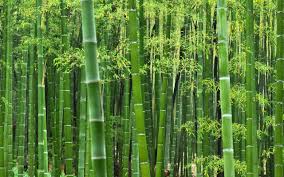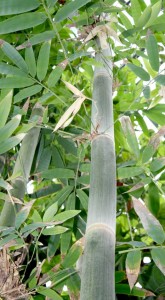Source: ecology.com
Published: May 15, 2013

Efforts to thoroughly study the role that plants play in climate change mitigation are increasing. Most researchers focus on the promise of large, leafy forest trees to help remove carbon from the atmosphere; for example Lal (1998) in India, Chen (1999) in Canada, Zhang (2003) in China, and Monson ( 2002) in the United States. This is because, generally speaking, the bigger the plant, the more CO2 it absorbs – and trees are the most obvious large plant species. However, there are some very large non-tree plants in the world and increasing evidence points to a surprising grassy climate change warrior: bamboo.
One species of bamboo, the guadua angustifolia, found in Venezuela, Ecuador, and Colombia, has been shown to grow up to 25 meters in height and 22 centimeters in diameter, with each plant weighing up to 100 kilograms (Rojas de Sánchez, 2004). This doesn’t match the stature of many trees, but it is still big enough to be significant. It is not all about size, however. How fast a plant grows has a part in determining how much CO2it can absorb in a given time. In this respect, bamboo wins hands-down: it grows faster than many trees, growing up to 1.2 meters per day. In fact, bamboo holds the Guinness World Record for the world’s fastest growing plant.
Bamboo’s other advantage is that it has great strength and flexibility, making it an ideal low-cost building material in many parts of Africa, Asia, and Latin America, areas where it is native. This means that bamboo in a plantation can regularly be chopped down and used to build houses and other structures, where the carbon remains sequestered for an average of 80 years (Castañeda, 2006), and that the plantation will recover quickly due to the fast growth rate. Because of this, the World Bank recently financed a project in Ecuador proposed by the International Network for Bamboo and Rattan (INBAR), an intergovernmental organization dedicated to improving the livelihoods of the poor producers and users of bamboo and rattan. The project is called ‘Elevated bamboo houses to protect communities in flood zones’ and has so far succeeded in developing and implementing techniques to construct ecological flood-resistant housing for low-income families using a type of bamboo that is native to Ecuador. The results currently include five, three classrooms, and two shelters. Elsewhere in the world, bamboo is also used to make boats (most commonly in Asia, but also in Ethiopia), furniture, flooring, clothing, paper, plastics, water pipes, and a very long list of other products. In cases such as furniture and flooring, bamboo provides an attractive and practical alternative to slower growing and less sustainable tree timber.

Tall bamboo. Photo: By 13dede on sxc
Bamboo’s carbon sequestration properties have been studied in countries where it naturally forms wild forests, such as Mexico (Castañeda, 2006) and China (Song, 2011). Contributing to these efforts, Ricardo Rojas Quiroga—an environmental engineering student at the Universidad Nuestra Señora de La Paz—studied Guadua angustifolia, a species of bamboo that grows in the Carrasco National Park of Bolivia. He measured the density and masses of bamboo plants in the forest, estimating the amount of carbon stored per hectare. Rojas concluded that, in addition to forming part of one of the most biodiverse ecosystems in the world, each hectare of the bamboo forest of Carrasco National Park stores levels of carbon comparable to some large tree species such as Chinese fir and oak. This finding is consistent with that of many previous studies, a review of which can be found in this 2010 report by INBAR.
This research is important because concrete numbers can more easily persuade policy-makers of the importance of bamboo forests, as well as other natural resources, in mitigating and adapting to climate change. For example, China has a native giant species of bamboo called Moso bamboo. One hectare (an area roughly the size of an athletics track) of this species can store up to 250 tons of carbon (Qi, 2009). Using data on CO2 emissions from the World Bank, this translates into the amount of carbon that was produced in 2009 by around 160 people in China (or, equivalently, 50 people in the U.S.A.). Each year, a hectare of Moso bamboo absorbs 5.1 tons of carbon, which can compensate for the CO2 emissions of three people in China (or one person in the U.S.A.). For reference, China has 3.37 million hectares of Moso bamboo (according to the State Forestry Administration of China) which accounts for around three percent of China’s total forest area.

Bamboo growing in big clumps. Photo: By revati_me on sxc
Once the relevant data has been collected, similar calculations can and should be performed for more countries, enabling politicians to allocate resources and priorities more effectively. It is important to note that INBAR and the other studies do offer a word of caution. Prioritization of one species over another for the purposes of carbon sequestration must take care, as figures are highly dependent on geographical and climatic conditions. It must also take into consideration the compatibility of the plants with the ecosystems in question.
Ultimately, the most effective solution to climate change is to decrease CO2 emissions by reducing dependence on fossil fuels. But, since a stage of zero emissions is highly unlikely in the near future, forests play a vital role in drive towards a more achievable state of carbon neutrality. Additionally, if countries such as those in South America can prove that their forests are removing not just their own country’s CO2, but also a lot of the carbon produced by other countries, it could be used to provoke rich, highly-polluting countries into contributing more towards the protection of these precious resources.
This article no longer exists at the Source link above. It can be found in the Matteroftrust.org Resource Library.
